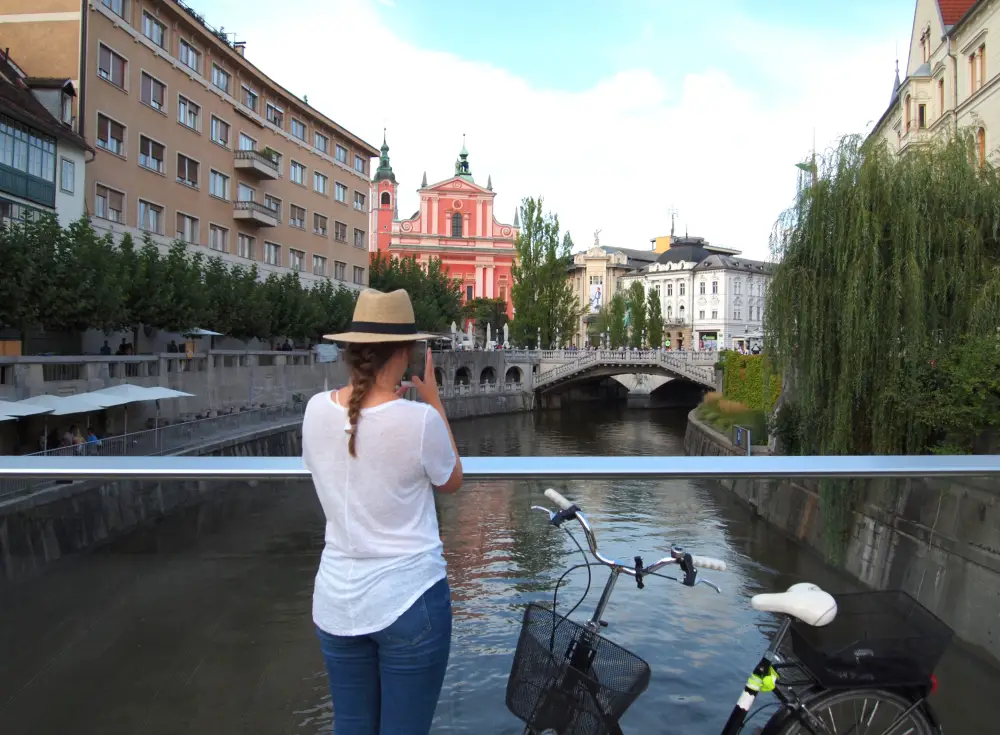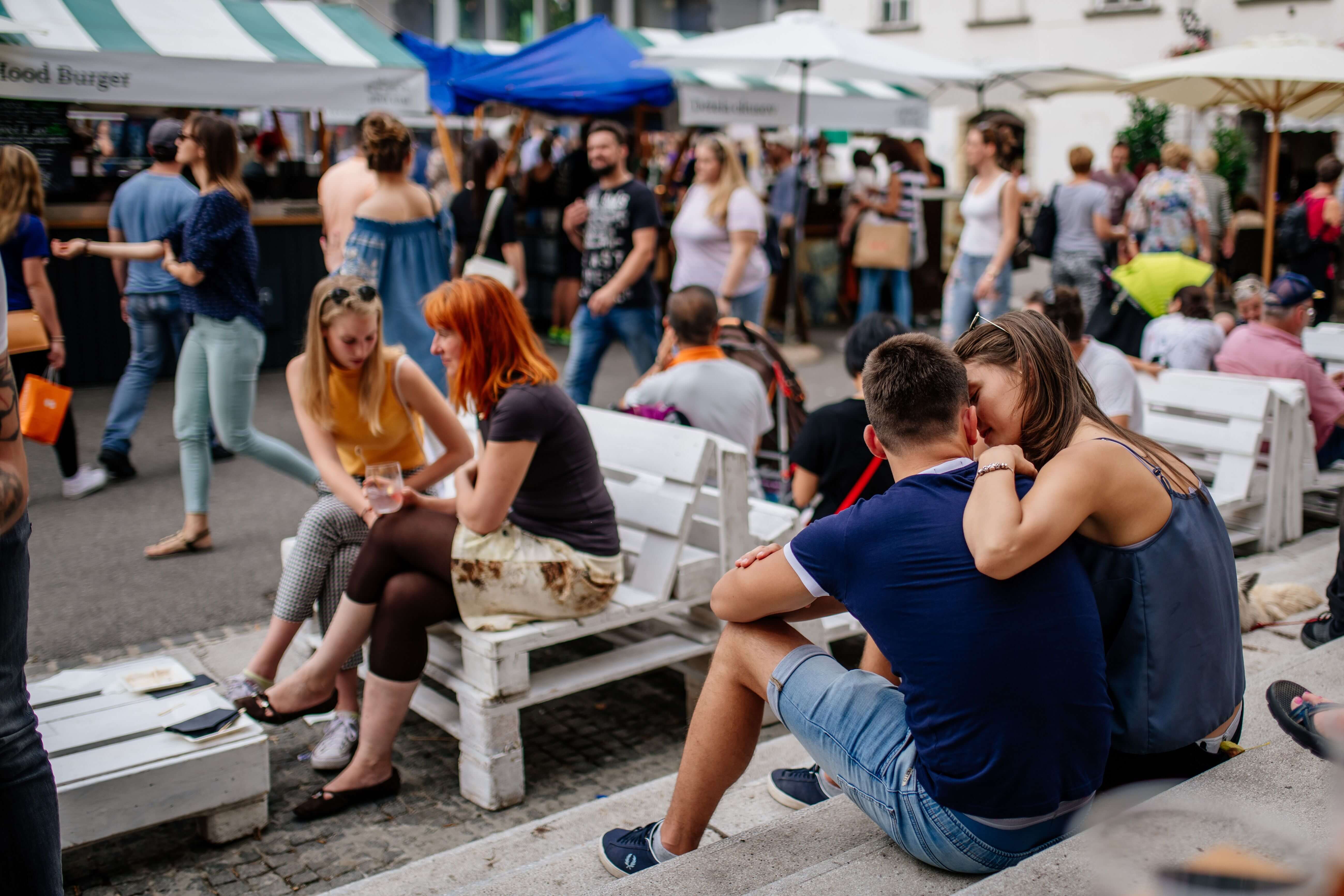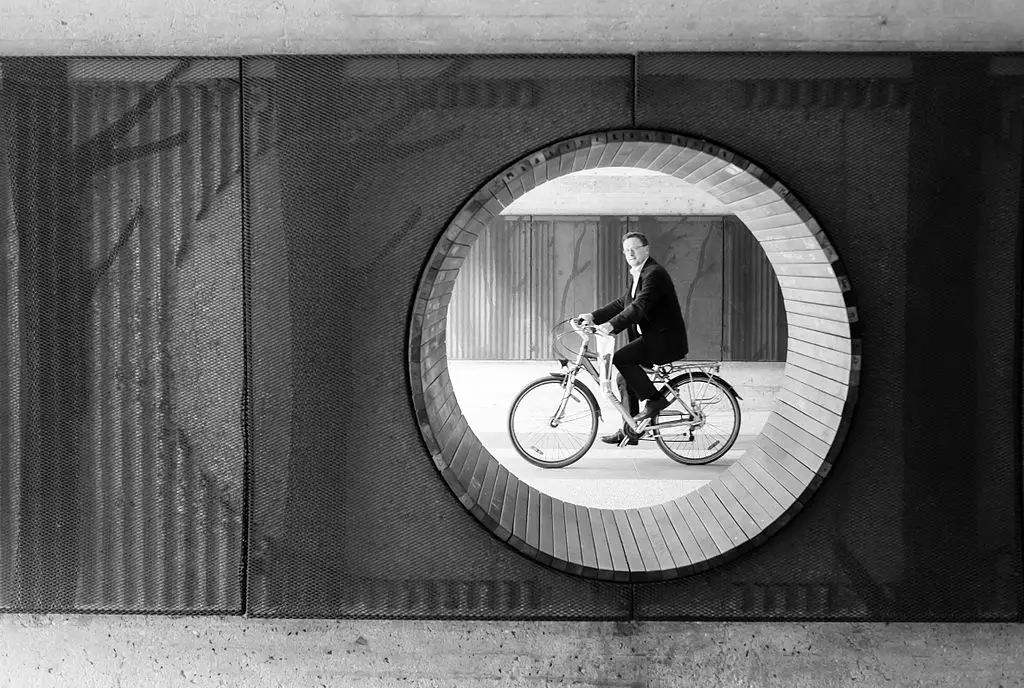Ljubljana related
SURS reports that 73% of Slovenian households could afford a one-week vacation away form home for all family members in 2018, the highest since such data started being collected (in 2005), and up one percentage point on 2017. More households in the Osrednjeslovenska statistical region (81%) were able to take a trip, while the lowest proportion was found for the Pomurska statistical region (61%).
The most common time for taking such a trip was the summer, July and August accounting for 18% of the total. The most common destination was Croatia (61% of all private trips made abroad), followed by Italy (7%), Austria (6%), and Bosnia and Herzegovina (5%).
Eurostat has also released data on the size of the EU population aged 16 or over could afford a one-week annual holiday away from home in 2018. Overall, the figure is 71.7%, an improvement on 2013, when just 60.5% of the population could afford a summer vacation. In contrast, Eurostat data finds that 78.2% of Slovenians were able to pay for a 7-day vacation
The countries with the most citizens able to travel were Sweden (90.3%), Luxembourg (89.1%) and Denmark (87.8%). At the other end of the scale, with the fewest individuals going on vacation away from home in 2018, were Romania (41.1%), Croatia (48.7%,), Greece and Cyprus (both 49%). The complete Eurostat dataset can be found here.
STA, 31 July 2019 - Slovenian tourism continued to boom in the first half of the year. Arrivals were up by over 6% compared to the same period last year to 2.6 million, with accommodation facilities recording 6.3 million nights, an increase of 10%, fresh statistics show.
While domestic arrivals increased just 3% to 733,000, foreign arrivals increased by almost 8% to 1.8 million, mostly due to increases in arrivals from the most important source countries.
There was a 13.5% increase in the number of guests from Germany, with arrivals from Austria and Italy rising by almost 6% and 3%, respectively, the Statistics Office said on Wednesday.
The picture for nights spent at tourist accommodation establishments is similar: foreigners spent 4.3 million nights in Slovenia, a rise of over 6%, while nights by domestic visitors were roughly flat at just over two million.
Among the largest source countries, the biggest increases were recorded for guests from Germany, Austria and Italy.
More details on this data can be found here
STA, 30 May 2019 - The government has taken a key step towards the creation of a state-owned tourism holding by confirming on Thursday an investment document facilitating the transfer of several tourism companies onto a special company.
The confirmed investment document allows the Bank Assets Management Company (BAMC) to incorporate a special purpose vehicle onto which shares of Istrabenz Turizem, owner of six coastal hotels, will be transferred.
This company will form the basis of the State Hospitality Fund, which is "key to the continued consolidation of Slovenian tourism," the government said.
The State Hospitality Fund will be created to pool together the assets of several partially or wholly state-owned tourism firms that are individually weak but will have significantly better investment potential when merged.
Once the firms are consolidated, they will be sold in what Economy Minister Zdravko Počivalšek has described as "reasonable privatisation".
The State Hospitality Fund will feature assets of Istrabenz Tourizem, Sava Turizem, Hoteli Bernardin, Adria Turistično podjetje, Hit, Thermana, Unitour and Terme Olimia spanning hotels, spas, campsites and ski resorts.
STA, 20 May 2019 - The peak cruise ship season has started at the Slovenian seaside, with some 2,500 cruise passengers sailing into the Koper harbour last Saturday and almost 5,000 being expected this week.
MS Mein Schiff 6, which is part of the TUI Cruises' fleet and carries more than 1,000 crew members in addition to the passengers, arrived in Slovenia's only sea port for the first time on Saturday.
Being almost 300 metres long and over 40 metres wide, Mein Schiff 6 is one of the biggest ships the harbour has ever welcomed, said the Koper municipality.
To mark the occasion, the municipality's representatives as well as representatives of the port operator Luka Koper met with the ship's captain.
The ship is one of the fleet's new vessels, being launched in January 2017, and it embarked on its maiden voyage in June 2017.
It offers mid-priced cruises, accessible to a wider range of customers, with a few suites designed for more high-end passengers.
Koper expects to welcome three cruise ships this week, including MSC Musica on Tuesday, Marella Discovery on Wednesday and Viking Star on Friday.
MSC Musica, carrying some 2,000 passengers, will sail from Venice and later continue its journey to Zadar in Croatia.
Marella Discovery visited Koper already at the beginning of May and will make a stop in the Slovenian harbour again during its voyage to Venice, carrying some 1,800 passengers.
Viking Star, on the other hand, is a luxury cruise ship, having space for almost 1,000 passengers.
STA, 19 April 2019 - Tourism contributed EUR 5.7bn or 12.3% to the Slovenian gross domestic product (GDP) in 2018, according to a report by the World Travel and Tourism Council (WTTC). The sector employed 110,700 people or 12.8% of total employment.
The annual contribution of tourism to the Slovenian GDP increased by 6% compared to 2017, the Slovenian Tourist Board said.
Related: 2018 Saw 8% Rise in Tourists, 10% in Nights, Strongest Growth from Abroad
In Europe, tourism contributed 9.7% to the GDP last year, an increase of 3.1 percentage points over 2017. Some 36.7 million people or 9.7% of all working Europeans were employed in the sector.
On a global scale, the tourism and travel sector directly and indirectly contributed EUR 7.825bn or 10.4% to the global GDP. The sector employed some 319 million people.
This year, tourism's contribution to the global GDP is set to increase by an additional 3.6%. The WTTC estimates that the total number of people employed in the sector globally will increase by 2.9%.
All our stories on travel and tourism in Slovenia are here
If visitors to Slovenia go to only one place outside the capital then it’s almost certainly to the picture perfect, chocolate box location of Lake Bled, famed for the views of the church on the island, castle on the hill, and kremšnita on the plate.
While four hours is just about enough to do it all, if you move fast, a day is recommended if you enjoy walking in the open air, and two days if you really want to soak it all in and see a little more of what the site has to offer, which includes swimming in summer, skiing and ice-skating in winter, and fairlytale views all the time.
Essential Sightseeing in Bled: The Island and Castle
The list of essentials around Lake Bled is fairly short and obvious. You’ll want to get good view of the castle and island, visit the island, and eat a kremšnita.
When it comes to the lake all eyes are on the island, with the Church of the Assumption of Mary (Cerkev Marijinega vnebovzetja). This was built in the 17th century and is approached via 99 steps that grooms are supposed to carry their brides up, with the island and Castle here being popular wedding spots. If no one’s getting married on your visit then do go inside and look around. You can also try ringing the bell three times for good luck, something you’ll hear others do throughout your visit.
You don’t need to pay to visit the island, so well done if you choose to swim there or bring your own canoe, but there is a fee if you want to enter the church and bell tower, currently €6 for adults, 4 for students and seniors, 1 for children, and 12 for families. Other places to explore on the island include the chaplain's house, provost's house, and a small hermitage – more than enough to make the trip across the water worthwhile, whether or not you have a wedding to attend.
The most touristy way to get to the island – not that there’s anything wrong with that – is via a traditional Pletna boat, powered by an oarsman who stands up (currently €15 return for adults, €8 for children), with these leaving from the Health Park, Hotel Park and the rowing centre (for more locations, see here). If you want to hire a kayak, rowboat or stand-up paddleboard, then Google will help, while if you come in winter the lake might be frozen, and you can simply walk or skate across (at your own risk, of course)
That said, you won’t get a good view of the island from the island, for that you’ll want to get up above the water. If you fancy a a short hike, of between 45 minutes to an hour in each direction, then three popular spots for this are the 611 m hill known as Ojstrica, or Osojnica’s two viewing areas, Mala (Small) at 685 m and Veliki (Big) at 756 m.
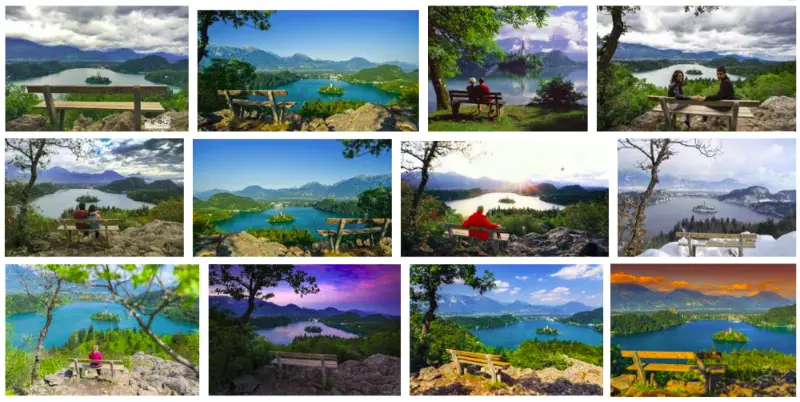
Source: Google image search
These are where you see a lot of Instagram shots, and you can find out how to take a picture like the ones above here. However, with about 90 minutes to two hours for the round trip you might want to find other options if just here for a short visit.
In which case, don’t worry, the view from Bled Castle is just as good. What’s more, if you’re really pressed for time then the short drive, bus ride or 15-minute walk up the hill will let you kill two or three birds with one stone – see the Castle, get the view, and eat one of those cakes, which we’ll get to, I promise.
The Castle, set atop a 130 m cliff, first appears in written records in 1011, and over the years the various owners have made their own changes to the property, making it the attractive mix of styles you’ll see today. Entrance costs €11 for adults, 7 for students and 5 for children enter (although free if you book a table at the restaurant), and inside you’ll find a museum, wine cellar, forge, printing press, chapel, knights’ hall restaurant, souvenir store and yet more impressive views of the area, which are not limited to those of the island.
What to Eat in Bled
Not every place has a “must eat” dish, but Bled surely does, and – as noted above – it’s kremšnita, which you’ll find everywhere. This is a truly delicious slab of custard, cream and pastry, perhaps best enjoyed with a cup of coffee. Another dish to consider, and before the kremšnita if you have enough time, would be fish from the lake.
If you’d like to make your own kremšnita, then you can see our recipe here. It failed, in part, but you can learn from our mistakes and / or simply appreciate the craft that goes into making “the real thing”.
Things to do with 24 to 48 hours in Bled
If you stay longer, and there are plenty hotels where you can spend the night, then you can really explore the area. In this regard hikers are in for a treat, with many paths and trails offering stunning views in the surrounding hills, or you can keep close to the water and follow the 6 km trail around the lake.
In the winter months skiing is possible, as is skating, while at other times you can enjoy a winter sport on rails with a toboggan ride – the details are here and a video is below.
Turning back to the lake itself,and season permitting, fishing is allowed, with Bled recently listed among the “ten best fishing holidays in Europe”.
While we’re on the subject of “best of” lists, golfers should note that in 2018 Royal Bled was added to the list of “best and most beautiful courses”, which is hardly surprising when you consider the views on offer as you walk from hole to hole.
Finally, if you’be spent a day or two exploring the area then consider taking a soak in one of the many spas in the town, with the water coming from the natural hot springs on the north-east side of the lake. In short, Bled offers much more than a cake with a view, and will reward visitors who choose to stay a day or two longer than most.
If you want to keep up with all the news about the area, including the things they don’t tell the tourists, then you can do that here, while if you want to visit the local tourist centre’s website to find out about the latest offers, then you can find that here.
Most visitors only spend a day or two in the capital, so what follows is a few suggestions on how to enjoy from four to 48 hours in Ljubljana, starting with the essential then going on to the more optional, and often more enjoyable, items. It’s a personal list with an eye to pleasing a wide audience, so feel free to disagree and choose your own adventure - I've been living here five years, and am still not bored with the city.
Related: 25 things to know about Ljubljana
The locations named in the text – all except the Zoo are close to each other
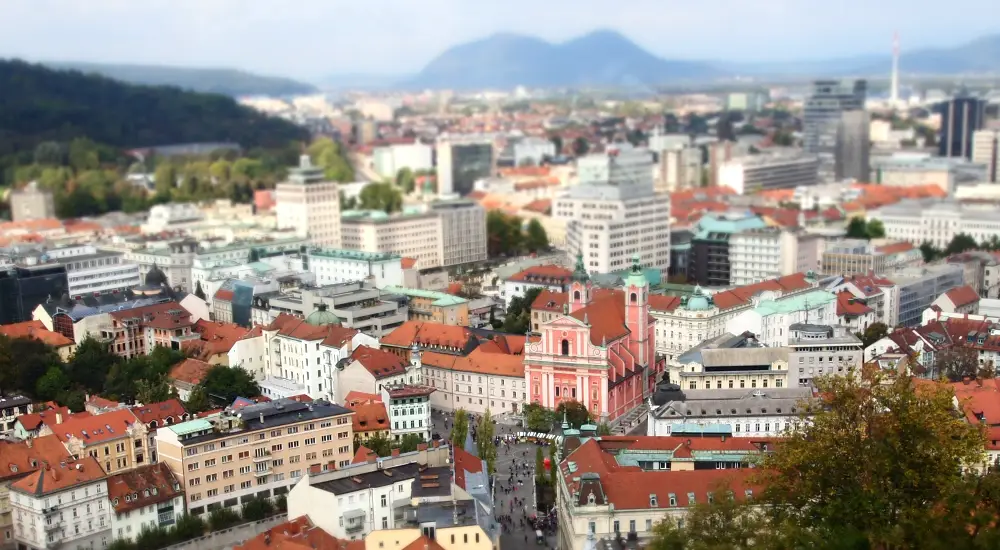
A view from the Castle: Photo JL Flanner
Essential Sightseeing in Ljubljana: The Castle and Old Town
If you only have a few hours in the city then there’s really only two things you have to do, see the Castle (and Old Town. If you’re able to walk then you can get to the Castle on foot in around 20 minutes and if not there’s a funicular (3) that’ll take you up and down a lot faster. But if you have the time and mobility then on foot is recommended, as you’ll save some money and get some exercise, along with an idea of how well defended the place was when attackers would need to trudge up while being fired down upon.
Much of the Castle can be enjoyed without a ticket, but if you do buy one you’ll get to go to the top of the tower for the best view in town, as well as entrance to various exhibitions. If you want to read up on the place beforehand, or while you’re there, then check out our 25 things to know… or 10 ways to enjoy Ljubljana Castle.
The Old Town is basically a street that runs from the Central Market (4) to Gornji trg (5), with the whole thing lined with attractive buildings housing boutiques, restaurants and cafés. You can easily go from one end to the other, without stopping too much, in 30 minutes, but you probably want to pause and explore, especially some of the lanes. You should also make time to walk by the River Ljubljanica, ideally along both sides so you get to see the colourful and well-preserved mansions that give this part of town a very picturesque chocolate box look.
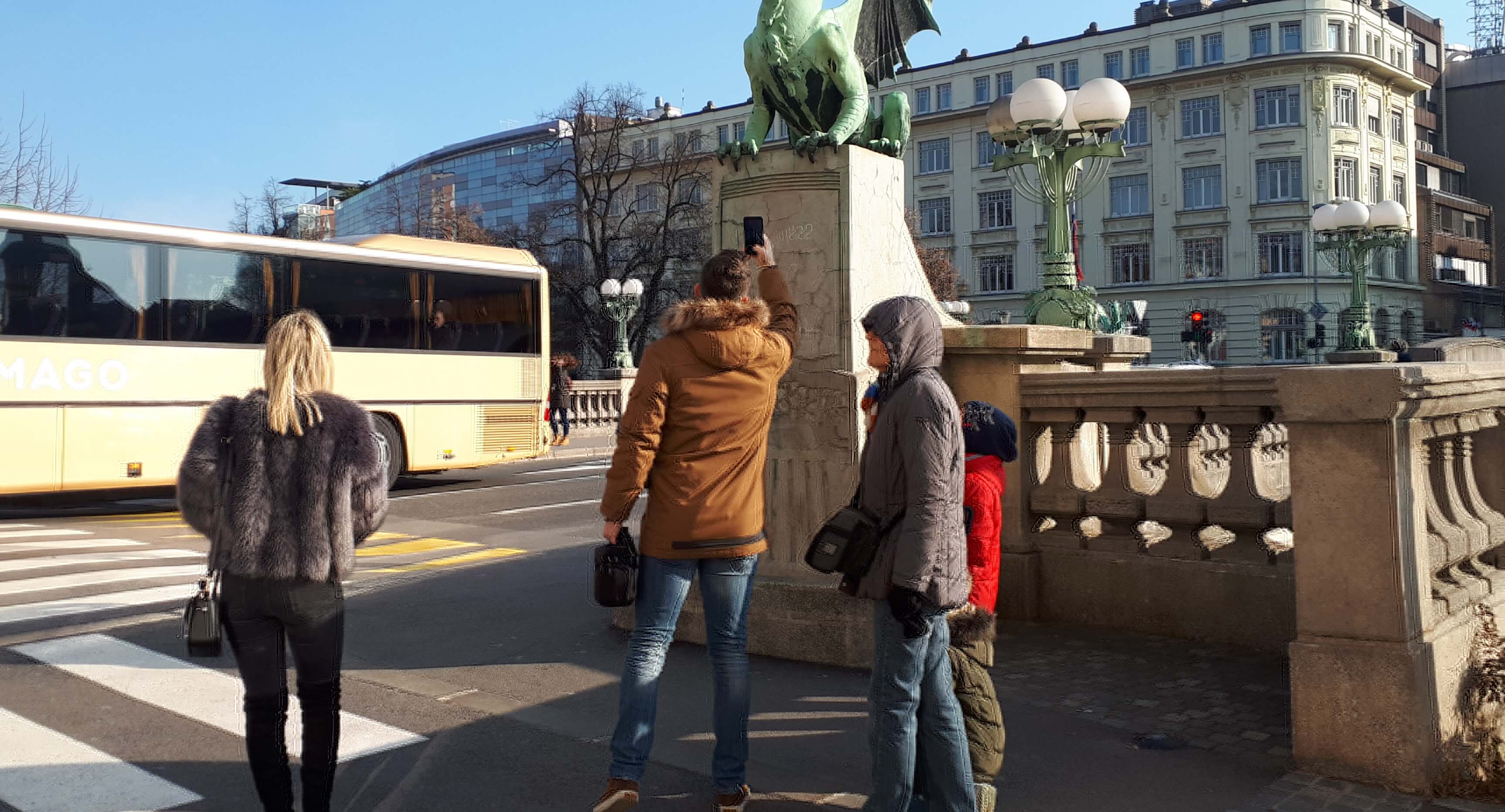
Everyone takes a picture at Dragon Bridge. Photo JL Flanner
Even if only in town for a half a day you’ll also want to see Dragon Bridge (6), although be prepared to be underwhelmed. Far prettier, in my opinion, are Triple Bridge (7) and Cobbler’s Bridge (8), and the best place to take pictures of both is from the easy to miss Fishmarket Footbridge, as outlined here.
Taking a picture from Fishmarket Footbridge. Photo JL Flanner
Things to do with 24 to 48 hours in Ljubljana
If you have more time in town then you can take in some culture, nature and nightlife, with plenty of options for all tastes, and all packed into or nearby the pedestrianised area.
“The best” is obviously subjective, so here I’ll just focus on the museums and galleries with the broadest appeal and biggest collections. If you like art then you’ll want to check out the National Gallery (9) and the Modern Gallery’s main branch (10), both near Tivoli Park. The former has everything from the Middle Ages to mid-20th century, while the latter contains the nation’s collection of modern art, with contemporary art housed in another branch by Metelkova. With regard to museums, the big two are the National Museum of Slovenia (11) and the City Museum (12), focusing on Slovenia as a whole and Ljubljana in particular, respectively.
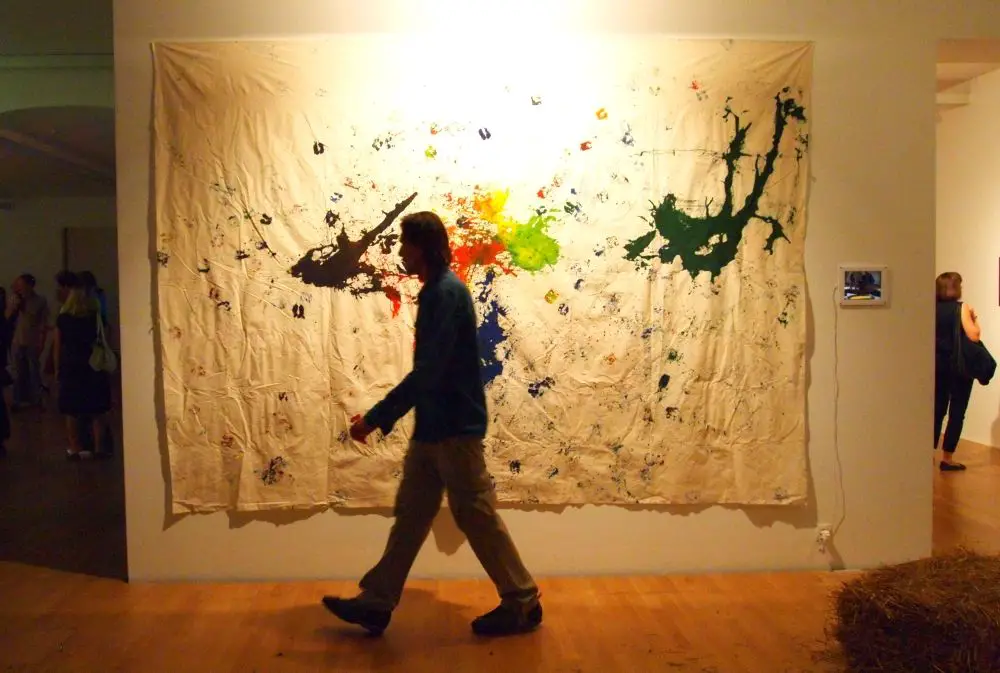
Contemporary art at the Modern Gallery's Metelkova branch. Photo JL Flanner
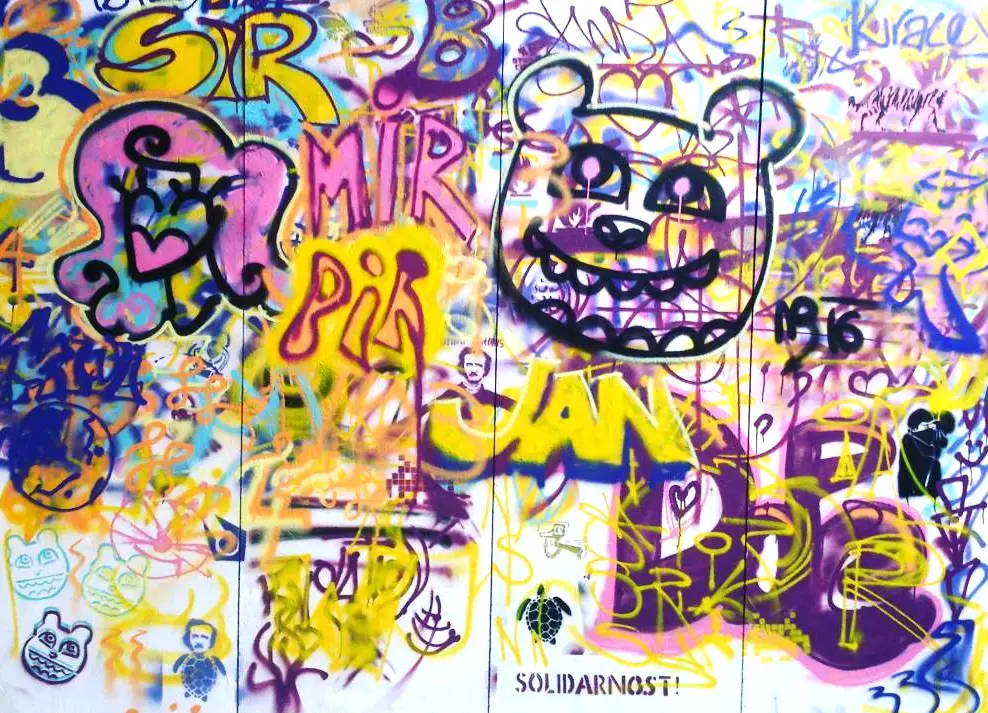
Street art: Photo: Alternative Ljubljana
Metelkova (13), the city’s graffiti-covered squat turned art space / autonomous area is worth visiting in the daytime to see the grittier side of the art scene, while at night it plays hosts to various music and performance venues. Note that unlike some similar looking places in Europe it’s not an open (or legal) drug market, so don’t go looking for trouble (or expecting it).
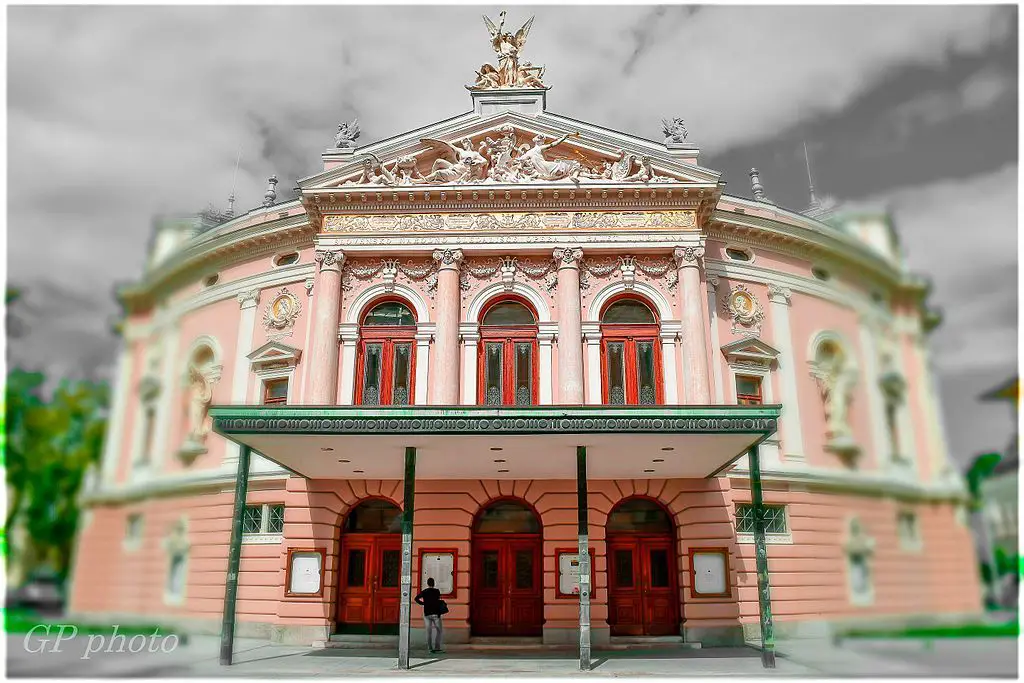
The Opera House is one of Ljubljana's many beautiful buildings. Photo: Wikimedia - Grega Pirc CC-by-4.0
For nightlife beyond cafés and bars there are plenty of clubs and live music venues, and a usual week will see these offering a broad range of music, from classical to techno, death metal to jazz, flamenco to dub, house music to experimental noise, with many all-night events, while there’s also a ballet and opera house, along with a number of cinemas. For all of these the best place to find out what’s on is TSN’s very own What’s on in Ljubljana this Week.
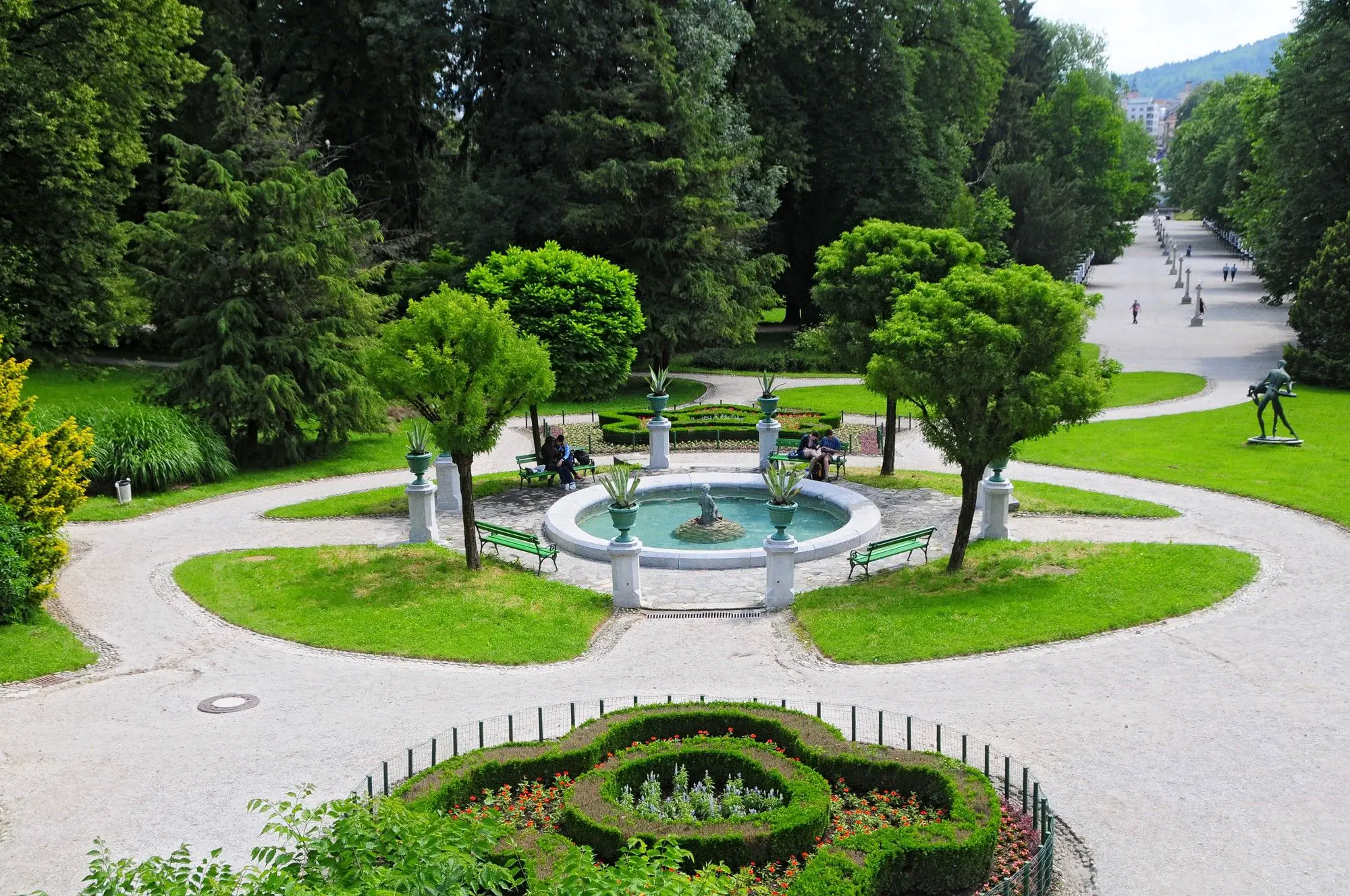
Tivoli Park. Photo: D Wedam for Visit Ljubljana
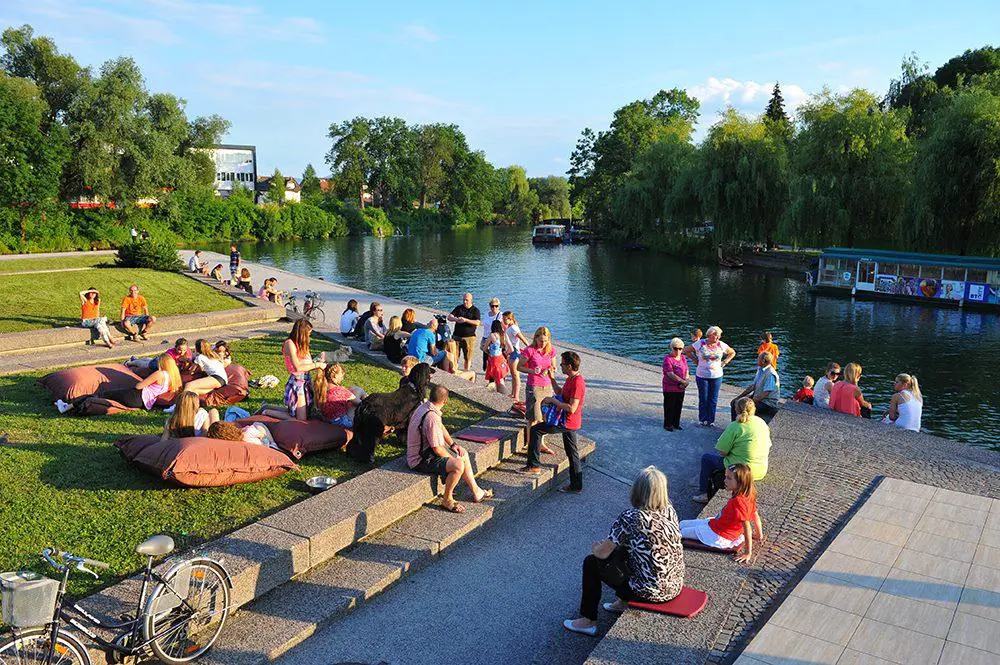
Further upriver. Photo: bananaway.eu
For children, in addition to the Castle, consider trips to the Puppet Theatre (near 3), the very popular Museum of Illusions or Ljubljana Zoo (13) (I haven’t been, but also haven’t heard bad things). Check out our obligatory Top 10 things for kids in Ljubljana story here.
Photo: Open Kitchen
Fine dining, street food and cafés in Ljubljana
If you want to eat “the best” then you can head to a review website and find something to your taste. The names that come up most with regard to fine dining are Strelec (in the Castle) and JB (14) on the architecturally interesting Miklošičeva Street , although check the prices before sitting down. Cheaper options are easy to find, and while Slovenian food is good there’s no real “must-eat” dish to put on your schedule, so relax and eat what you want. If that’s “ethnic food”, then head to Trubarjeva cesta (15) . If hungry after midnight then your options are very limited, but a few places can be found here. If visiting in the warmer months, and on a Friday, then don't miss Open Kitchen in the marketplace next to the Cathedral.
With regard to cafés and bars, the best thing is just to find somewhere with a free table that looks like your kind of thing, order a drink and settle down, as with most of the places you get what you see or hear from the outside.

Photo: JL Flanner
Tourist shopping in Ljubljana
Ljubljana isn’t known for its shopping, with most of the more functional stores out of town at the massive BTC shopping complex, which isn’t really worth visiting if you’re a tourist. No, if you’re just looking cute boutiques and places to pick up a souvenir then the Old Town will have you covered, while if you need any toiletries or stationary then head to Müller (16), on Čopova (near the McDonald’s).
If you need prescription drugs, or even just aspirin, head to the Lekarna (17) in Prešeren Square (the one with the big pink church by Triple Bridge). When I travel I like to visit supermarkets, both to pick up some snacks and drinks for my hotel room, and to get some idea of the local products on offer. The two main chains in town are Spar and Mercator, which you’ll come across just walking around. However, note that while this is a capital city there are no 24-hour, or even very late night, convenience stores, so do your shopping before 20:00 or risk disappointment.
Photo: Wikimedia - Thomas Geiregger CC by 2.0
Getting around Ljubljana
Everything is within easy walking range, if you find walking easy, although if you want to experience the city “like a local”, and see more, faster, then rent a bike. These can be borrowed from the city’s Bicikelj system, but can also be rented from various hotels and hostels, so if you’re spending the night somewhere ask there. There are city buses, but if you’re only in town for a day or two then you’re unlikely to need one.
If you’re in a wheelchair or less mobile than you’d like then don’t worry. Ljubljana is an old city, and there are still steps in many places, but the municipality is also working hard to improve accessibility. The best way to learn about this, and to find out which places have ramps, where the Eurokey bathrooms are, and so on, is with the Ljubljana by Wheelchair app.
In short, whether spending four or 48 hours in Ljubljana there's plenty to enjoy without feeling too rushed, and if you’re a first-time visitor then I envy the pleasures of discovery that await you.
STA, 7 March 2019 - Ljubljana, the lakeside resort Bled and several other Slovenian towns included in the Slovenia Green scheme have been awarded at ITB Berlin, one of the world's largest and most prominent tourism trade fairs.
Ljubljana won in the category Best in Cities with its campaign promoting local food production entitled the Exchange of Local Foods.
The first meeting of producers and potential buyers of food from Ljubljana and central Slovenia was held in February and attracted more than 80 food producers, representatives of schools and kindergartens, hotels and restaurants.
"Locally produced ingredients are a trend in modern cuisine that is becoming an increasingly important element of Ljubljana's tourism, so we plan to continue with the Exchange of Local Foods ..." said Petra Stušek, the head of Turizem Ljubljana.
We just kicked off @ITB_Berlin 2019 with 35 Slovenian tourism partners ?
— Feel Slovenia? (@SloveniaInfo) March 6, 2019
?Visit us at Stand 109, Hall 17 and explore the culture and beauty of your favorite destination!
?https://t.co/F1OMIiM4TQ#ITBBerlin #ifeelslovenia #myway #itsculturetime pic.twitter.com/QoPz2zzcrY
Bled received the second prize in the category Best in Europe, which Tomaž Rogelj of Turizem Bled sees as a reward for the town's efforts in environment protection. It is also an encouragement for new measures promoting sustainable tourism, he said.
Meanwhile, Komen, Rogaška Slatina, Idrija, Koper and Podčetrtek were among the 25 finalists in the category for their efforts for responsible tourism, the Slovenian Tourism Board (STO) said after the accolades were handed out on Wednesday.
The Sustainable Top 100 Destinations awards are conferred by an NGO promoting sustainable tourism, Green Destinations, which declared Slovenia the first green country in the world in 2016.
Last year, Slovenia was among the top six most sustainable destinations in the world and the top in Europe.
A total of 64 destinations, service providers, parks and travel agencies in Slovenia are currently included in the Slovenia Green scheme and another 11 are to be included shortly, the STO said.
March 9, 2019
Human history is a story of migration, and Slovenes are no exception.
In the last century and a half many Slovenes emigrated to various New Worlds, especially North America, with the diaspora finding new homes far from the land of their birth. As such, over time and with each generation their hometowns became more and more distant, until their descendants lost touch with their roots.
As such, tor many who would like to reconnect with their family origins and explore their roots a little, or a lot, of help is often needed. And this is where Urban Gulič Tomšič comes in.
Urban, what exactly do you do?
I am an ancestry guide, sometimes I also call myself an ancestry detective as my job involves a lot of investigative work.
Say I was a USA citizen who had just discovered I had some Slovenian roots and would like to learn more. How could you help me?
My help would almost certainly begin with an exchange of emails. You would need to give me all the information you’ve got so that I can have some grounds on what or who we are looking for. I advise clients about the time they might need in Slovenia, locations to stay and visit, and information to help them travel hassle free to Slovenia. However, my actual services begin with data-gathering and investigation, be it on my own or together with my clients.
We begin with gathering the information in your country, in the example of someone in the US one of the resources is Ellis Island records of immigrants, and then proceed with our work in Slovenia. In many cases the names of towns and villages are in German and also in various fonts, such as Gothic script. It happens as well that five or more villages of the same name emerge while looking for a person’s place of origin. I clarify all this and prepare the grounds for our common investigation.
The next step is to go and visit the related archives. I sometimes do this task on my own in case my clients don’t have enough time for a long enough visit.
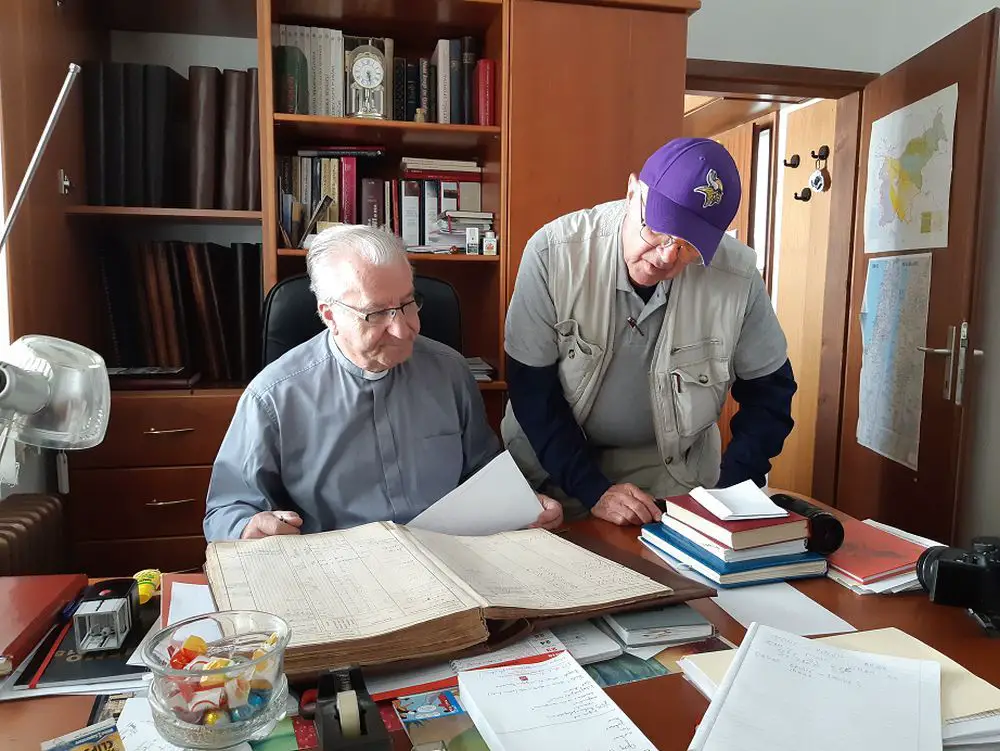
Equipped with this data we then go on our trip around Slovenia. We visit local parishes and check their archives as well, old cemeteries, we knock on people doors and pieces of information start to come together.
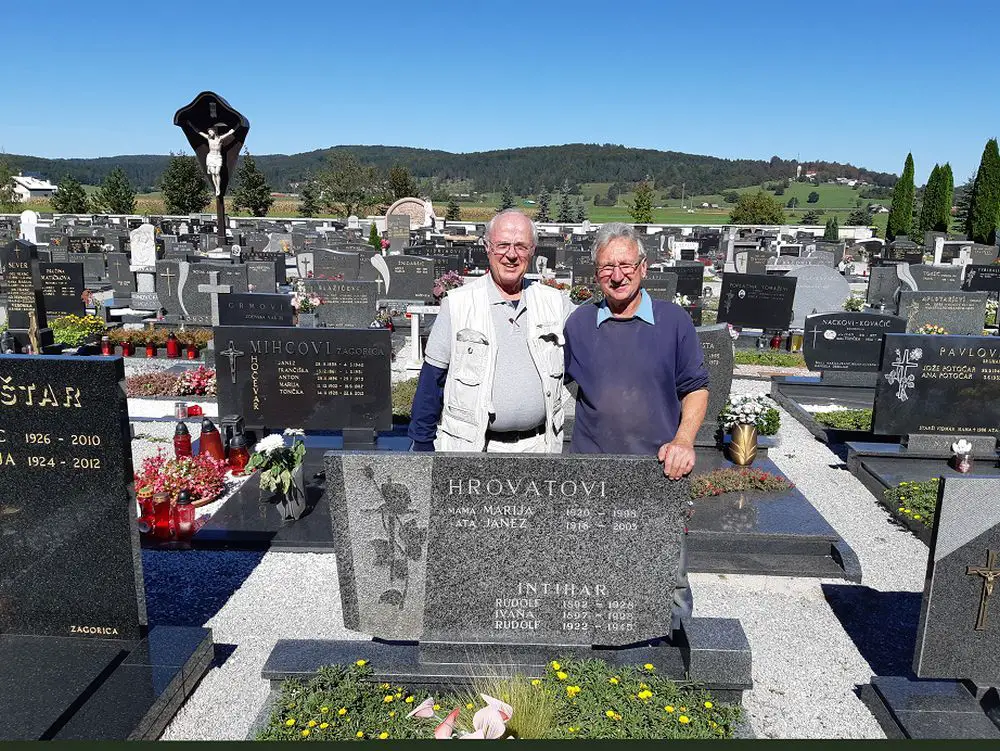
Most of the times we meet living relatives, find old houses or their ruins, even neighbours in possession of old photos and oral history.
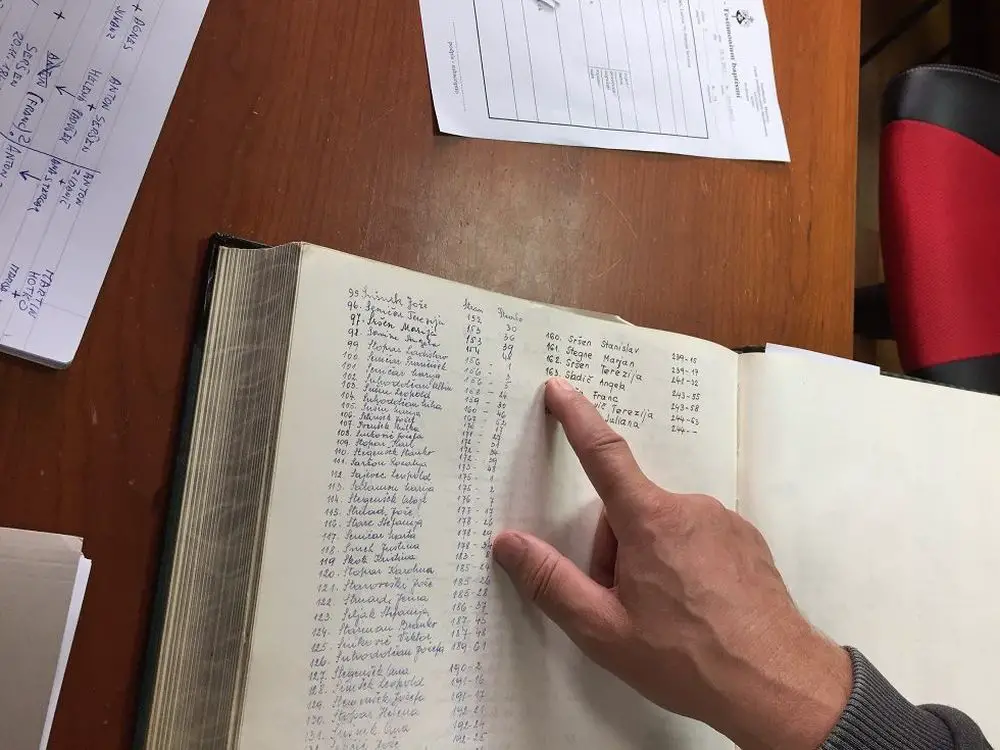
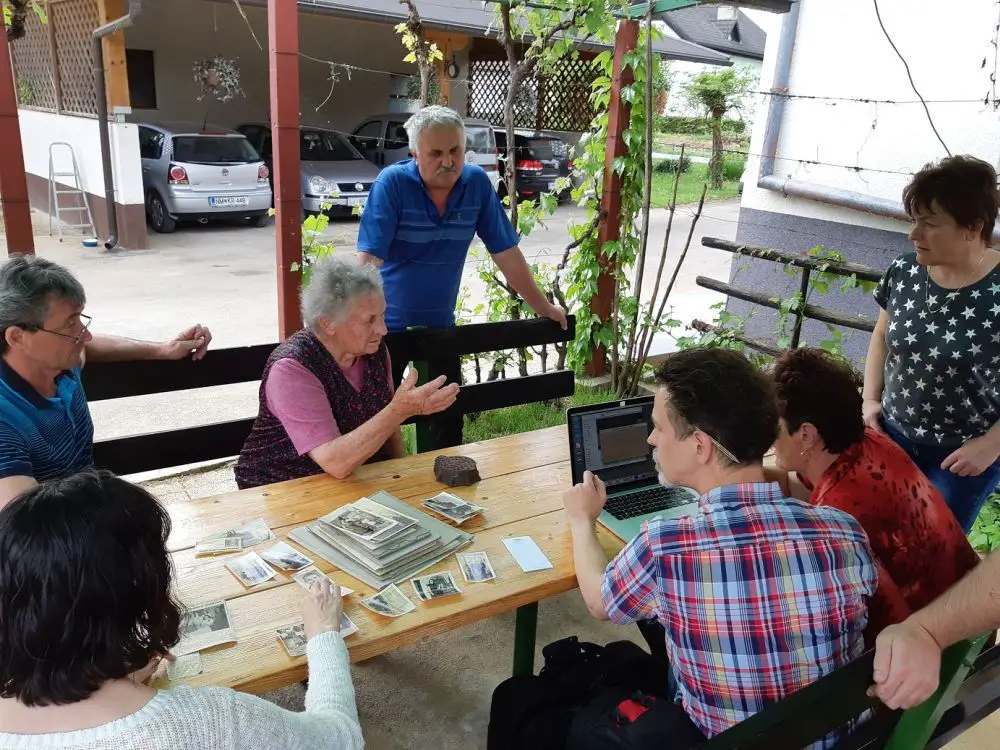
Photo: Ancestry Slovenia
How come you decided to do this?
My friend and a fellow tour guide Barbara once called me to help with ancestry guiding, because one of hers colleagues got sick. I took the tour and got immediately hooked. I enjoyed the company of my clients but also the research, it made me feel like Sherlock Holmes. I also felt very happy when we found what we were looking for. I wanted to do more of this so I launched my own Slovenian Genealogy website.
Where do your clients mostly come from?
Most of my clients come from the USA, mainly Cleveland and Chicago, as well as California, but I get people from everywhere Slovenians moved long enough ago for their descendants to have lost touch with the old country.
Which part of Slovenia do your clients mostly originate from, is there a region that stands out in this respect?
Many people emigrated from the areas of Posavje and Dolenjska (Lower Carniola), as the living conditions at the end of 19th century were really bad in these areas. In general the majority of my research is conducted in the eastern part of Slovenia.
My clients are mostly descendants of this first wave of emigration (roughly between the years 1880 and 1920), which was predominantly economic in nature. Those who emigrated for political reasons following the end of WWII mostly haven’t lost a touch yet, as this wasn’t that long ago.
As a tour guide, what are the places you would recommend to visit in Slovenia besides the usual destinations of Bled, Ljubljana Castle and Postojna Cave?
Basically in Slovenia whether you head in one direction or another you can stumble upon a place of beauty: Soča Valley, the lovely city of Piran on the coast, the wine region of Goriška brda, Lake Bohinj, Velika Planina, the Mercury mine of Idrija and Škocjan Caves, to name just a few.
Urban, thank you for talking to us.
For more information please visit Ancestry Slovenia.
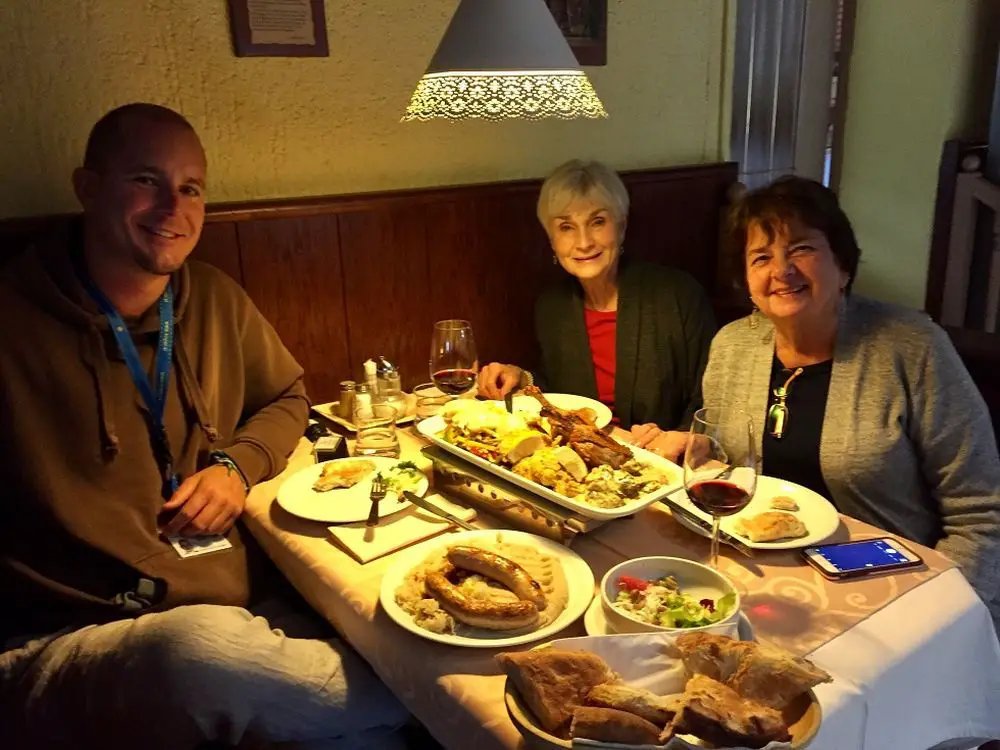
Related: How Braziian fever led many Slovenes to South America
A leisurely walk in the woods in many countries, especially in my home country of England, invokes an image not only of peace and tranquillity, but also one of relative ease and safety. One of the advantages of the UK is that nothing really dangerous lurks in our woods; other than the odd crazy person with an axe or a gun. In Slovenia however, while you are less likely to encounter an axe-wielding homicidal maniac, there are other more natural dangers to be aware of: bears!
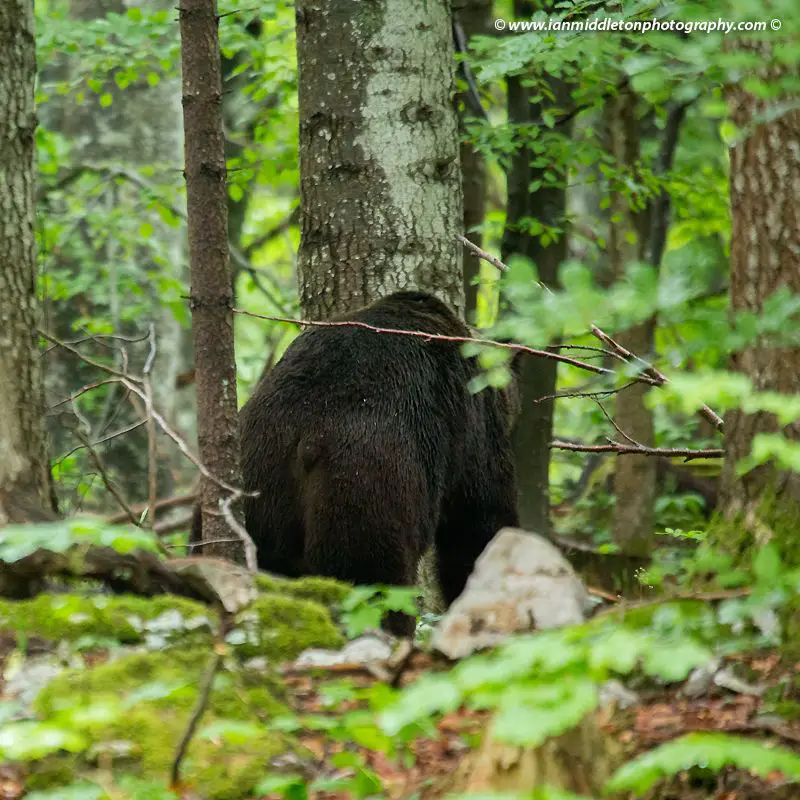
Brown Bear in the forest in Notranjska, Slovenia.
If you go down to the woods today, the likelihood that you’ll encounter a bear is extremely low. Over the years I have frequently gone driving and walking in areas where I had hoped to see or photograph them. Not a single sighting. Yet there is an estimated 800-900 European Brown Bears in Slovenia, bearing in mind (pun intended) that many of these bears and other wildlife routinely wander between Slovenia and Croatia. The brown bear is an elusive creature and at best it’s safer to go with a hunter, or an organised tour.
A few years back I did manage to find someone who had setup a series of hides specifically designed for photographers, so I was able to finally go on a bear watch and capture some great photos. However, while these are ideal for serious amateur or professional photographers, they are not so good for tourists who simply want to see the bears but don’t have the expensive camera equipment required to photograph them.
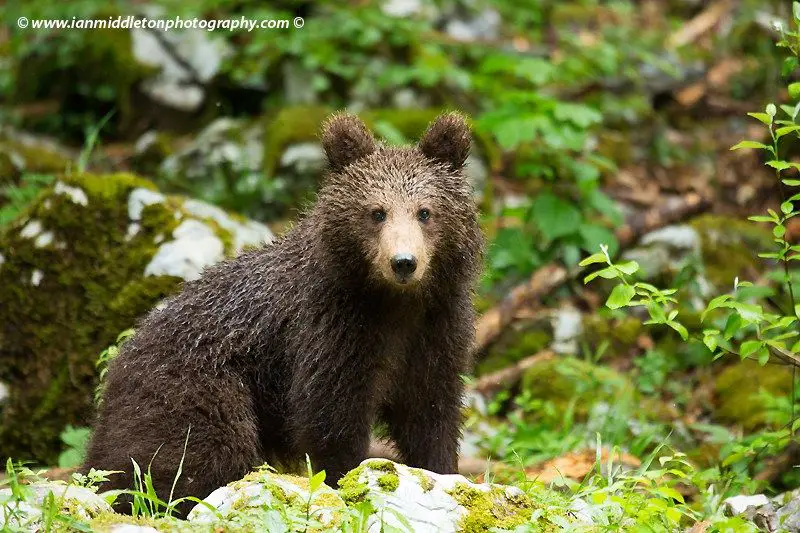
A one year old Brown Bear Cub in the forest in Notranjska, Slovenia.
So imagine my delight when I found Bears and Wildlife Tours. Based at the tourist office in the little village of Hrib, in the municipality of Loški Potok, they offer an array of wildlife watching tours as well as bear viewing huts. But the most intriguing of all, was the offer of staying the night in a simulated bear cave. I had to go and see.
The journey took me south from the capital Ljubljana to the border with Croatia, where I met with Tjaša, who organises and coordinates the tours, and Stanko, a local hunter and guide. We were already late into September so they told me that the chances of a sighting were low because the bears usually come out late in the evening, and as the sun is now setting earlier it would more than likely be dark by this time. But they would take me to see what they had to offer anyway.
Over a strong cappuccino, they told me a little about the bears and what they offer. They currently have about 7 hides in total, 3 in the Loški Potok region. This gives them much more scope to ensure a sighting for their guests. “We have never seen the same bear at each of our hides. The bears travel around 60kms per night or day. Many go from Loški Potok to Cerknica, and of course across the border,” said Tjaša.
The bears tend to travel over a specific area. A mother bear can remember from 5 years before where she got a good meal. Amazing, I struggle to remember where I ate yesterday!
Their numbers are increasing. In 1960 there was an estimated 150 bears in Slovenia. In 2018 that number was around 900. These numbers apparently swelled during the Balkan conflict; where many bears I guess fled here for asylum! I asked how it’s possible to know the numbers. “Hunters collect bear poo and send it to Ljubljana to the institute and from the DNA they can estimate their numbers. Every year the number is increasing,” replied Tjaša.
Mother bears in Slovenia are now giving birth to 3 cubs instead of 2. Rarely before have bears had more than 2. This is also an indicator that the quality of their habitat and food source is improving. 2018 was a particularly good year for food, as conditions that year made not only the forest rich with food, but the village orchards were overgrown with fruit. Stanko explained to me how September 2018 has seen an unusual rise in bears coming into the villages, much more than previous years. In autumn the bears are fattening up for the winter hibernation.
The improved quality of the habitat is partly down to conservation work, and rules being enforced that prevent hunters or bear tour organisations from feeding the bears within 2kms of a village. This helps stop them from wandering into villages in search of food and prevents any incidents with locals, and also accidents with cars. One of the biggest threats to bears is being hit by cars.
Every year the government sets an annual cull to try to control the population. For 2019 it was 200, increased from previous years because of the reasons above. However, this decision was suspended by the administrative court after a case was brought by the environmental protection organisation Alpe Adria Green (AAG).
A Winter Den and Bear Jacuzzi
After coffee we headed out for the first part of the tour. Stanko drove us to a location a few kilometres outside of town, where we stopped beside a forest road. He pointed to the forest and said that just up the hill is a winter den for a mother bear.
Bear dens are always close to water, so they can often be close to the road and village. Stanko and Tjaša then pointed to a stream running out of the forest to the roadside and told me how the bears will seek out sources of water, especially when it’s very hot.
These pools of water or streams are mostly deep in the forest well away from people and villages. However, they are also found on roadsides like this close to villages, because the water that runs off the forested hillsides collects in pools by the road. Stanko regularly comes here deer hunting and told me how, early one morning around 5am, he spotted a bear immersed in a pool of water up to its neck, with just its head poking out the surface.
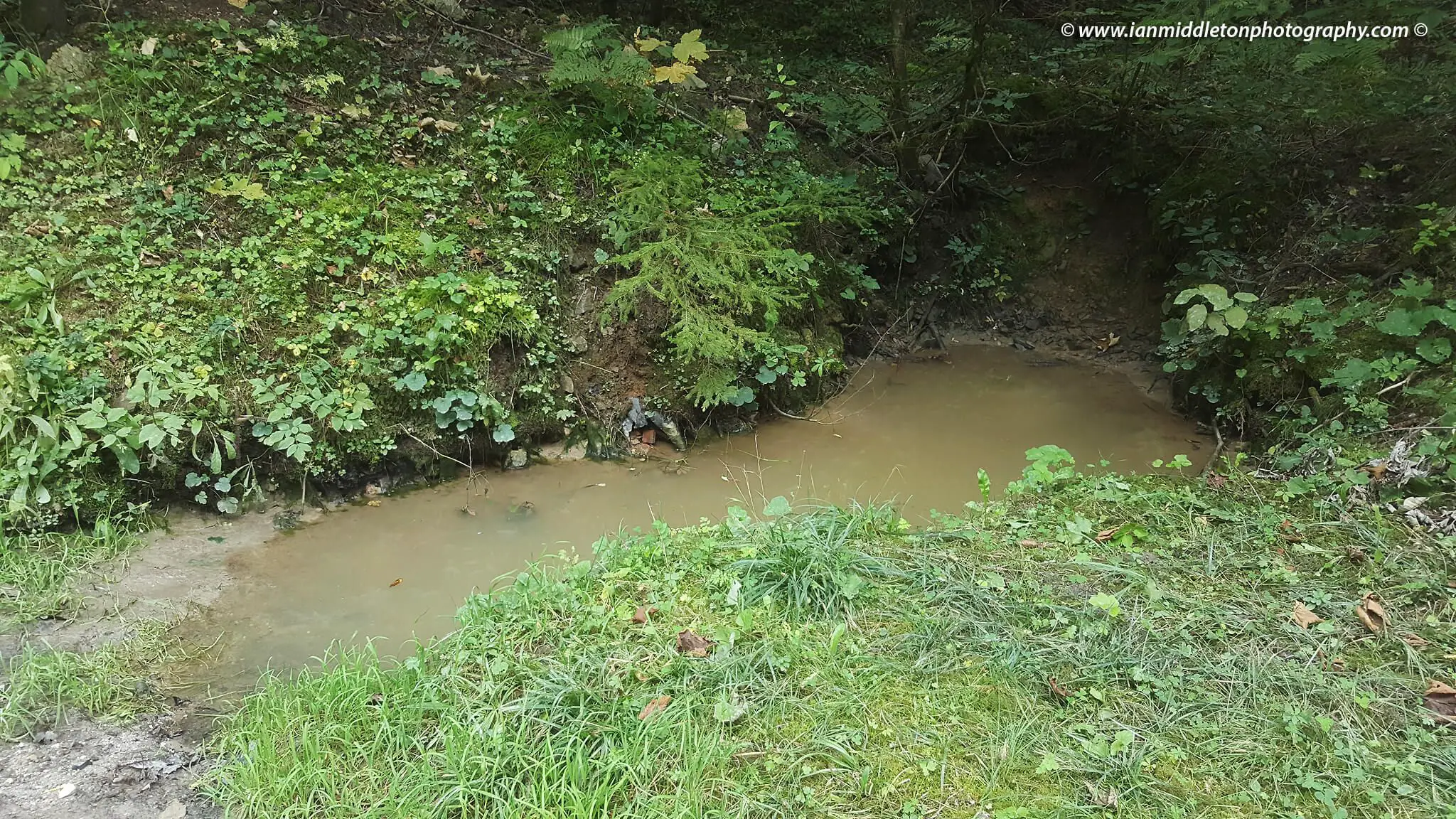
“I call it the Bear Jacuzzi”, he laughed.
The bears often come to these roadside pools to cool off in the heat of the summer days, and Stanko, and likely many locals, see them as they drive these forest roads.
Mushrooms – A national sport
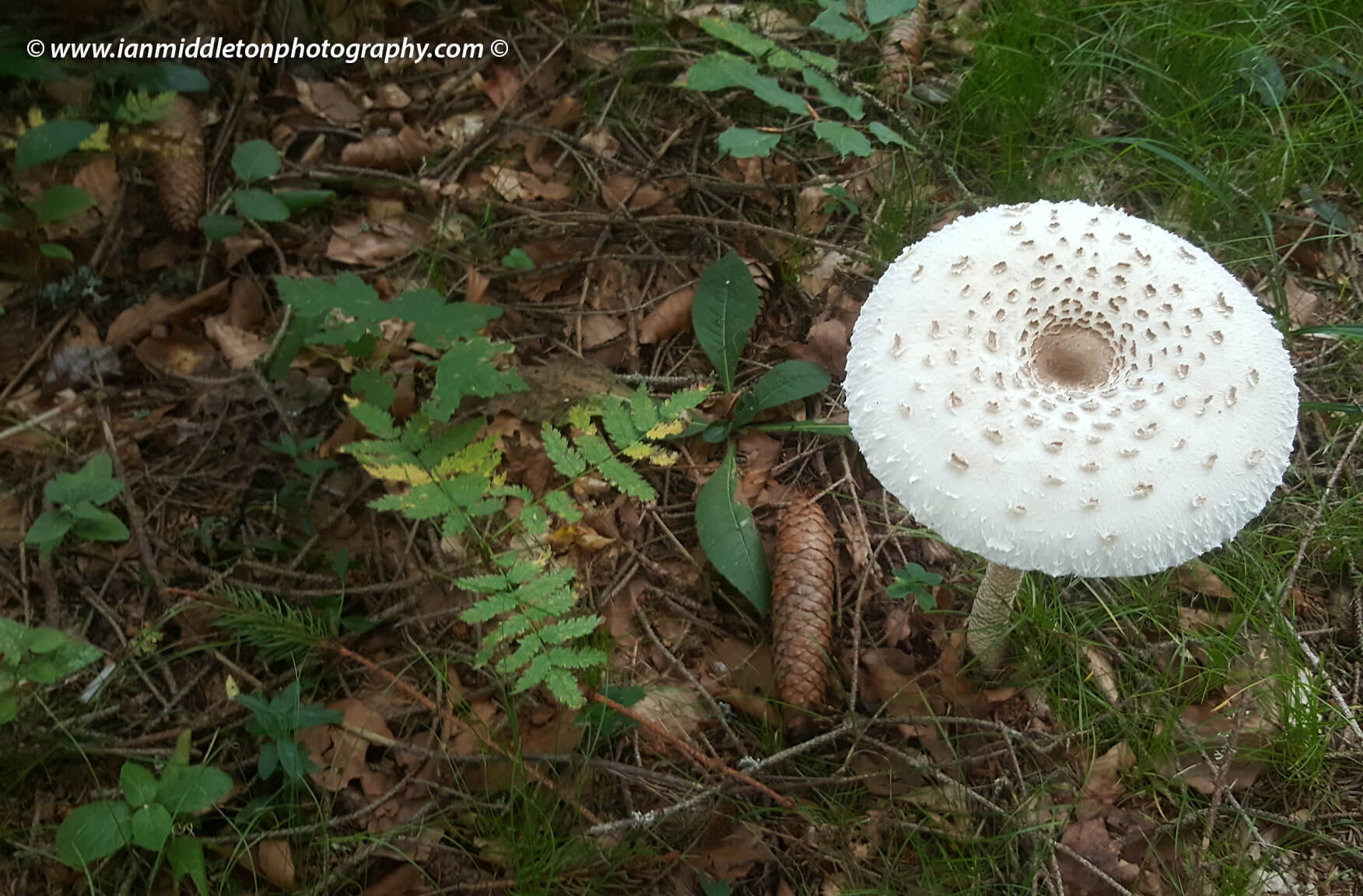
Wild Parasol mushrooms, known as Marela in Slovenia.. Macrolepiota procera or Lepiota procera
I then followed them up the hill to the winter den. On the way Tjaša picked some mushrooms and described how to prepare them. Mushroom picking, along with other forest fruits, is a national sport here in Slovenia. Every season the forests are packed with locals out mushroom picking, and they are usually racing each other to get the best and most. She also explained how to tell the difference between a poisonous and non-poisonous one.
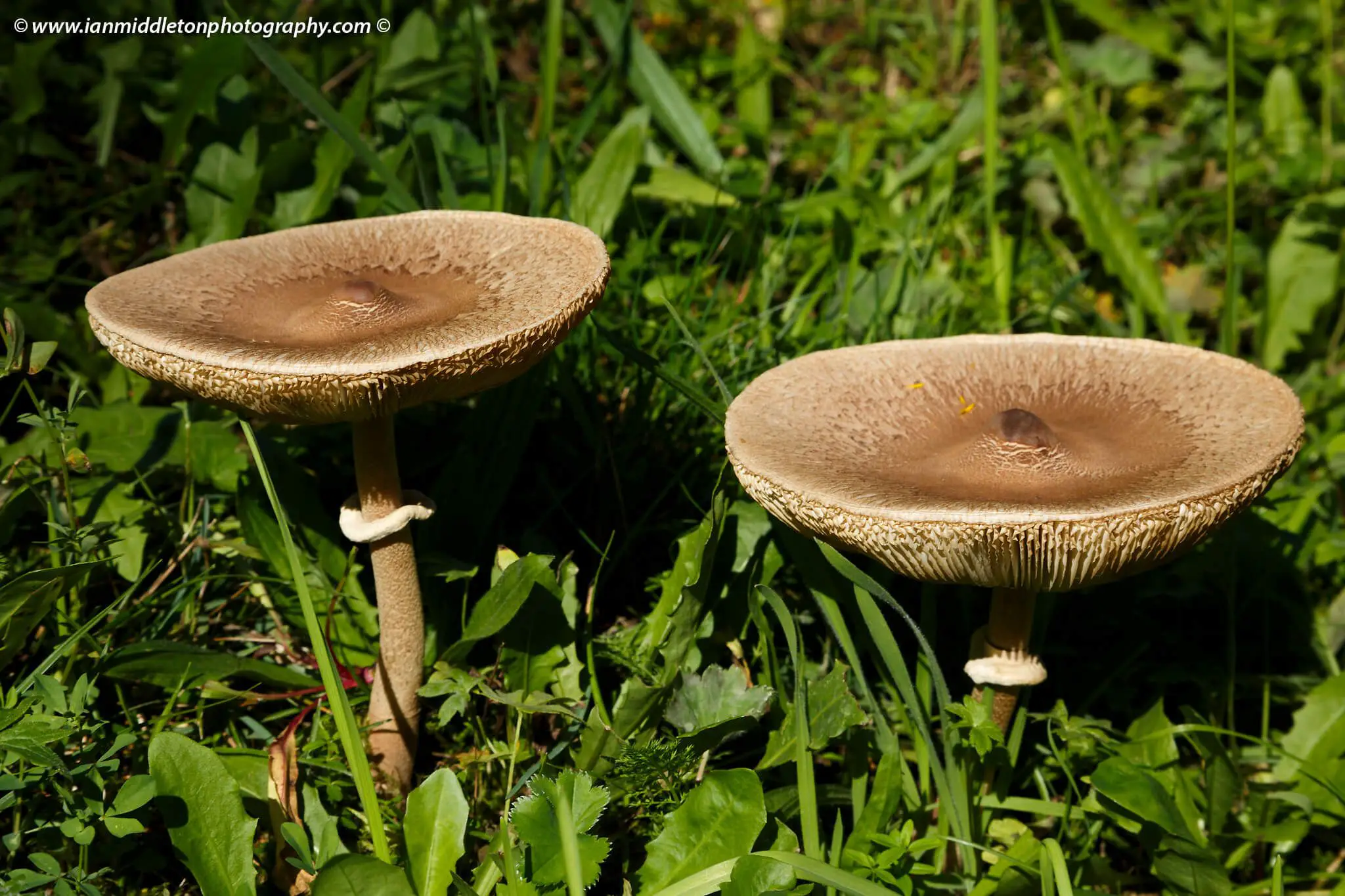
Wild Parasol mushrooms, known as Marela in Slovenia. As you can see, on the stem this circular piece is an indication that the mushroom is non-poisonous.
“I’ll take these to my mother in law’s tomorrow for cooking,” I said.
I feel I should add here that I fully intended to give my mother in law the non-poisonous mushrooms.
Slovenian folklore says that if you see a mushroom in the forest you must pick it immediately, no matter how big or small it is. Once someone has seen it, the mushroom will stop growing. Tjaša also explained that when you pick a mushroom you must clean it there and then in the forest before you take it away.
The bear cave
Bears hibernate during the winter in a den, essentially a small cave deep in a hillside. The entrance is narrow, but inside it is very wide and deep. The bear can get inside because its head and neck are very small and it doesn’t have a collar bone, so can squeeze its body through.
The bears enter the den when the first snow comes, or before if it’s a pregnant female. She will give birth in January and emerge from the den in April with her cubs. The cubs remain with the mother for two years. Therefore the bear has cubs every three years.
The male bear typically weighs 300kgs, while the female weighs 150kgs, so they can tell by the small size of the den that this is for a female only.
Responsible tourism
Bears and Wildlife Tours believe in keeping tourism to a minimum. Therefore they don’t have tours every day in the same location, so the wildlife isn’t disturbed too much. Bears can smell fresh blood from up to 4 kilometres away, and have excellent hearing too. If too many people are around the bears will hear and keep well away. Unless you are hunting!
On the way to our next destination, the viewing cave, Stanko told me a story about a time he shot a roe deer. Afterwards he placed his rifle against a tree and proceeded to cut open the deer and gut it. When he had finished pulling everything out, he took the gutted deer to his vehicle about 400 metres away.
Upon his return, Stanko got to within 100 metres to discover that between him and his rifle was a big male bear feasting on the leftover deer. It was not the most ideal of circumstances, so Stanko had no choice but to patiently wait before he could retrieve his firearm.
So to not only ensure the safety of visitors, but also ensure they don’t scare away the bears and other wildlife, they practice responsible tourism and ensure the numbers are kept low, and wildlife tours are conducted in different places each time.
There are very strict rules governing hunters and tourist organisations offering wildlife tours or trips to see bears in Slovenia. Along with the 2km rule, it is forbidden to feed the bears with farmed meat. But when gutting a deer it’s permitted to leave the leftovers in the forest for the bears to find, as long as they don’t find you first! But while an attack is undoubtedly terrible for the victim, it also means a death sentence for the bear. Once a bear has attacked a human being, it will be hunted down and killed. So these rules are not only there to protect people, but to protect the bears too.
Despite its love for meat, bears are actually 90% vegetarian. A sobering thought when you are just about to trudge through bear country.
Off to the bear viewing cave
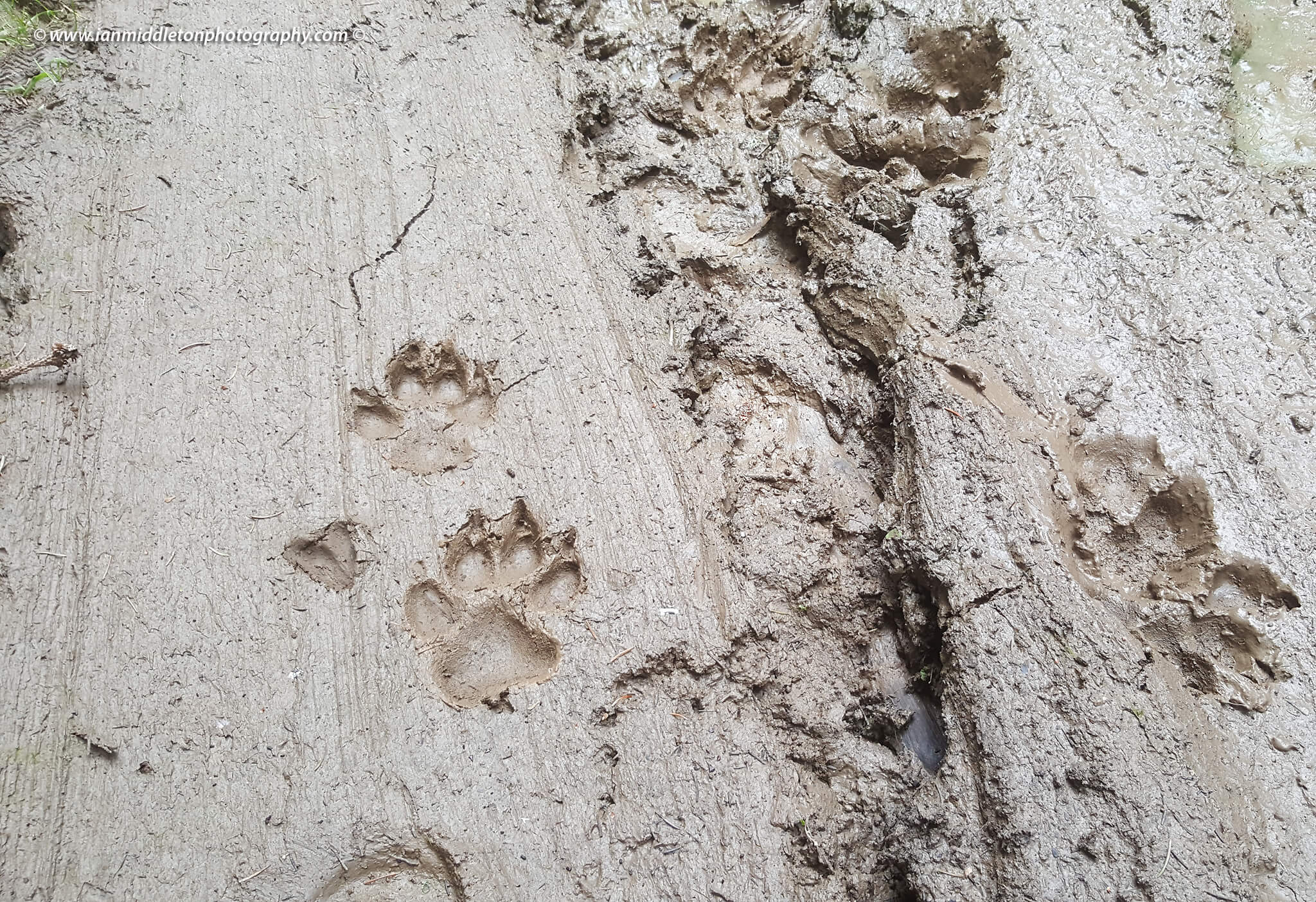
Wolf footprints in a forest in Loski Potok, Slovenia
We then headed off to the starting point of our walk deep into the forest to one of their viewing huts and, in this case, the bear viewing cave which you can sleep in. Along the way we spotted some wolf tracks, apparently attracted here because it’s deer mating season. As we got deeper into the woods I was told that from here on we must be very quiet and talk in whispers, or else the bears will sense us. In our case, we were here to spot them, so didn’t want to scare them off.
I just hoped the big bucket of apples that Tjaša was carrying wouldn’t encourage them to overcome their fear of humans!
What to do if you encounter a bear
Contrary to popular belief, bears are not the man-eating beasts they can often be portrayed as. In fact, they are very nervous creatures and will likely hear you first and keep well away. Attacks are usually the result of a bear being startled by a walker, or often a bird watcher who is not making any noise; or a photographer sneaking around to take photos. The bear will only attack if it sees no means of escape. Or if you inadvertently come between a mother and her cubs, you’re in for trouble.
Ordinarily when walking in the woods the advice is to never walk alone, and walk and talk (but don’t shout), make as much noise as possible in order to stay safe and avoid startling a bear, or other wild animal. This way the bear will hear you first.
There are many stories about what to do if you happen to surprise a bear. Although the instinct is to run, this is apparently the worst thing to do. A bear can run much faster than you, and if you run it will see you as a threat. Some say you should grab a stick and make yourself look big and loud. If the bear charges at you, remain still. Chances are it is a bluff and will veer away at the last minute.
Another crazy theory I heard is that you should run downhill, because the bear’s front legs are shorter and it cannot run fast downhill. But Tjaša laughed and said that the bear will still outrun you.
Tjaša’s advice is simple: back away slowly, always keeping your eye on the bear and it will very likely run away from you.
The Bear Cave
When we arrived at the viewing spot, a wide open meadow at the edge of the forest, Stanko went off alone first to check it was safe. Then they both prepared the food they would put out to try and attract the bears; Tjaša didn’t touch the food to ensure any human scent was kept to a minimum. For obvious reasons, the area was a short distance away from the viewing area. Tjaša explained that, for the reasons above, Stanko alone must go; no one else, not even her.
This particular viewing area is actually right beside the Croatian border. There are two places from which to observe the bears. The first is a viewing hut setup for both photographers and casual observers. The second is the specially designed bear cave. Here they have built a small wooden room into the rocks that is designed to simulate a bear’s den. Inside I was surprised to discover a cosy double bed and a row of seats next to small windows that look right out across the field to where the bears will hopefully come.
Stanko returned with a special night vision camera that they clamp to a tree where the bears are. It is triggered by movement so they can see when they are active at night. The previous night they came at 9pm, after dark. This was not looking promising for me. But as they had explained I was well into September now so the chances of a sighting during daylight were much lower.
The camera also showed a bear was here at 8.30 in the morning. So this goes to show that a night in this bear cave will undoubtedly increase your chances of a sighting. Sadly, commitments elsewhere meant I couldn’t stay the night.
The best time to take this tour is in high summer, from late May through June and July. August is also a possibility. The tours start at 16:00 and end at 22:00. There are several observation points like this, all on hills in areas of wide open space with lots of light.
But there is only one bear cave, and in this case you get to spend the night here. Naturally this increases your chances of a sighting, because you can also wake early and likely see them in the early morning.
Soon after, Tjaša and Stanko left. Just before he bolted the door, Stanko looked at me and said: “Do not go outside.”
I had no intention of doing that.
I was alone. All was quiet. I settled down for the evening, camera ready. When I had been on the photography tour a few years before we were extremely lucky that, not more than 30 minutes after settling into the observation hut, a couple of one-year old cubs came, followed by the mother and soon after a big male.
As the time ticked away I continued to live in hope. A bird of prey was swooping by occasionally, but sadly no bears.
Stanko returned to collect me after dark, and we trudged on through the forest without torches back to the car. Along the way he told me how he had been privileged to see a lynx in the forest. The Eurasian Lynx was reintroduced to Slovenia in 1973 by a hunter’s initiative. The current population is estimated at about 15-20. Thus not only are their numbers low, but they are very shy animals so a sighting is extremely rare. He showed me a photo he had. “It was a big privilege for me,” he said, proudly.
The love and respect that both Stanko and Tjaša have for the bears and other wildlife is clearly evident.
All this just goes to show how difficult it can be to spot the wildlife, and how important it is to go with an organisation like Bears and Wildlife Tours. Not only will they ensure your safety, as long as you follow their rules and instructions to the letter, but it will increase the chance that you too will be privileged enough to see one of these magnificent animals in their own habitat.
I had seen them before, but sadly not this time. However, I plan to return in May or June for another tour, and maybe even an overnight stay in a bear cave!
How to go
If you would like see bears, then visit the Bears and Wildlife Tours website. They also offer other wildlife tours, including as well as the bear cave, the opportunity to sleep on a rocky shelf in the forest and experience the sights and sounds of nature, with your guide there to keep you safe.
More info and bookings here: www.bearsandwildlife.si
Check out a video of the trip below:
For a more comprehensive look at Ian’s photography, check out his free e-book here. You can see many images in higher resolution, find other photo posts and subscribe to his newsletter here.


